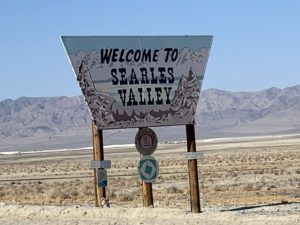
California experiences back-to-back earthquakes
 California is on edge after a series of earthquakes, including two major back-to-back temblors, struck a remote part of the Mojave Desert region during the Fourth of July holiday weekend. At 10:33 a.m. local time on Thursday, July 4, 2019, a 6.4 magnitude quake struck a sparsely populated area about 122 miles northeast of Los Angeles and just 11 miles northeast of the city of Ridgecrest. It was the most powerful earthquake to hit Southern California in nearly 20 years and was felt as far away as Ensenada and Mexicali in Mexico; Las Vegas and Reno in Nevada; Phoenix, Ariz.; and Chico and Oceanside in California. That quake was followed by more than 400 aftershocks — ranging in magnitude from 2.0 to 5.4 — and scientists from the United States Geological Survey (USGS) warned that a powerful aftershock of the same 6.4 magnitude or greater was a possibility.
California is on edge after a series of earthquakes, including two major back-to-back temblors, struck a remote part of the Mojave Desert region during the Fourth of July holiday weekend. At 10:33 a.m. local time on Thursday, July 4, 2019, a 6.4 magnitude quake struck a sparsely populated area about 122 miles northeast of Los Angeles and just 11 miles northeast of the city of Ridgecrest. It was the most powerful earthquake to hit Southern California in nearly 20 years and was felt as far away as Ensenada and Mexicali in Mexico; Las Vegas and Reno in Nevada; Phoenix, Ariz.; and Chico and Oceanside in California. That quake was followed by more than 400 aftershocks — ranging in magnitude from 2.0 to 5.4 — and scientists from the United States Geological Survey (USGS) warned that a powerful aftershock of the same 6.4 magnitude or greater was a possibility.
Just a day later, at 8:19 p.m. local time, an even larger quake of magnitude 7.1 — which is 11 times more powerful than the July Fourth event and estimated to have been felt by some 15 million people — struck about 6.8 miles northwest of its predecessor and is now among the most powerful quakes in California history since the magnitude 7.1 Hector Mine Earthquake struck the Mojave Desert in 1999. The 6.4 temblor, which occurred in the Little Lake fault zone, is now determined to be a foreshock to the 7.1 Searles Valley Earthquake, which occurred in the Airport Lake Fault Zone; both complex fault zones in the Indian Wells Valley area. Both faults are located about 100 miles northeast of California’s most-feared San Andreas Fault.
The back-to-back quakes left behind more than 50 damaged structures, broken roads, rock slides, obstructed railroad tracks, and leaking water and gas lines in the small Mojave Desert communities of Ridgecrest and Trona. No fatalities or major injuries were reported. About 200 people opted to sleep in emergency shelters as crews canvassed the towns to assess for damage. The Naval Air Weapons Station China Lake in the Mojave Desert — the U.S. Navy’s largest single landholding — was evacuated and operations halted as most employees live off the base and in Ridgecrest. The epicenters of both quakes were on the base, and officials said they are continuing to assess damage.
The sparsely populated location of the Searles Valley Earthquake appeared to mitigate the damage. Only 28,000 people live in the Ridgecrest area, and about 2,000 people live in Trona. Experts said it could have been much worse. A similar temblor in a densely populated urban area — such as the magnitude 6.7 Northridge Earthquake of 1994 or the magnitude 6.0 Napa Valley Earthquake of 2014 — would have undoubtedly meant deaths and severe property damage in the billions, according to the California Earthquake Authority.
A team of structural engineers and geologists — including engineers from the Structural Engineers Association of Southern California — conducting reconnaissance in coordination with the Earthquake Engineering Research Institute’s Earthquake Clearinghouse have observed that much of the residential damage sustained in the two recent earthquakes correlates to the age of the homes. In Trona where the building stock dates back to the 1930s–50s, there was increased damage. More modern buildings in Ridgecrest fared better, with most damages observed being limited to nonstructural elements or contents. However, additional aftershocks may increase damage, cause older homes to shake off their foundation, or cause the collapse of buildings or structures that were compromised during this recent significant event.
Existing buildings that are not significantly renovated or altered to protect against earthquakes are the single biggest contributor to seismic risk in the United States today. Certain types of buildings, such as unreinforced masonry structures, have performed poorly in past earthquakes and are known to be particularly hazardous. Some local governments in high-hazard areas have enacted ordinances mandating that owners evaluate and retrofit these buildings.
Seismic retrofitting of vulnerable structures is critical to reducing risk. It is important for protecting the lives and assets of building occupants and the continuity of their work. On the whole, communities with more retrofitted structures can recover from earthquakes more rapidly and there is no more important factor in reducing a community’s risk from an earthquake than the adoption and enforcement of up-to-date building codes.
“It is a wake-up call for the rest of the state and other parts of the nation, frankly,” said California Governor Gavin Newsom during a press conference and tour of the affected region. Newsom said that much of the damage can’t be seen by walking down the street, but only by walking through people’s homes. “It’s deceiving, earthquake damage. You don’t notice it at first.” It is estimated that economic damage will be in excess of $100 million. And recovering from structural damage to a home or even broken windows or appliances is a costly financial burden for individuals and small businesses. Newsom said the state and federal governments are committed to the community’s recovery and declared a commitment to better prepare for earthquakes, including strengthening alert systems and building codes.






